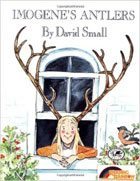By Phyllis Root and Jackie Briggs Martin
Who doesn’t go a little wild when spring finally arrives? And even though we set out to choose pairs of books to write about, this month we couldn’t resist a hat trick of three books. At the heart of each is not only wildness but also how those around us react when our wild natures leak out.

At the center of the first two books is a yearning to live in the world of one’s own choosing. In Where the Wild Things Are, the book against which we still measure all other picture books, Max, sent supperless to his room for wild behavior, conjures up a forest, a boat, and an ocean and sails away to where the wild things live. The wild things make him their king, and he declares a wild rumpus — until he becomes lonely and wants to be “where someone loved him best of all.” When Max sails back into his own room, his supper awaits him, still hot and proof that his mother does indeed love him. With Sendak’s clear concision of language and syntax, we’ve gone on a wild journey, complete with rumpus, and returned to know we are loved. Best of all.

Mr. Tiger Goes Wild’s eponymous protagonist also yearns to live by his own rules. Even Brown’s art makes the case in the beginning that Mr. Tiger is a more colorful character than the upright townspeople, shown in shades of brown and gray while Mr. Tiger himself is orange down to his dialogue bubbles. Bored with being proper in a proper society, he walks on all fours, roars in public, and swims in a public fountain. When he emerge clothes-free, he has clearly gone too far, and the townspeople strongly suggest he take his wild self off to the wilderness, where he goes complete wild — until he, too, grows lonely. Returning to the town he dons a tee shirt and shorts that his friends provide him and discovers that the townspeople themselves have changed. Some go on all fours, some walk upright, some still dress elegantly, some wear casual clothes. In this changed society (and changed, we infer, because of Mr. Tiger’s actions) “Mr. Tiger felt free to be himself. And so did everyone else.”

Imogene in Imogene’s Antlers has wildness thrust upon her in the form of an enormous pair of antlers with which she awakens one Thursday. While the antlers complicate her morning routine (“Getting dressed was difficult, and going through a door now took some thinking”) Imogene seems cheerily accepting of the transformation. Not so Imogene’s mother who faints when she sees her daughter’s new appendages. Imogene’s brother Norman takes the academic approach and announces that Imogene has turned into a rare miniature elk. Their mother faints again. An attempt to hide the antlers under an enormous hat leads to still more fainting. Unlike Max’s mother, who loves her wild son best of all, or the townspeople who ultimately accept Mr. Tiger for himself, Imogene’s mother cannot cope. Luckily, the cook and kitchen maid admire Imogene’s antlers, deck her out with donuts for the birds, and look forward to decorating her come Christmas. At the end of her eventful day Imogene kisses her family and heads to bed. The next morning her antlers have disappeared. As she peeks around the corner into the kitchen, her mother is overjoyed that Imogene is back to normal — until a smiling Imogene enters the room, her peacock tail spread behind her. We assume that fainting follows.
While Imogene doesn’t choose her changes and never engages in anything wilder than sliding down the banister, she copes admirably with the unpredictability that marks childhood. At times we all might need to look for support and love beyond the folks from whom we most expect it and remember to love our own wild, clothes-free, or antlered selves.
Wildness, love, acceptance. Who doesn’t want it all? And why not? What’s against it?
So go ahead.
Be a little wild.
Like characters in these books, we promise we’ll still love you.

So what’s against it indeed? Wonderful post for a June morning.